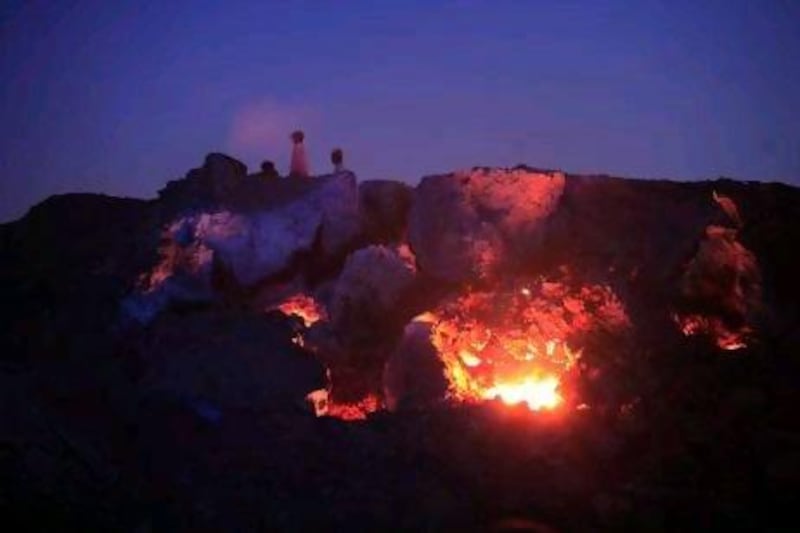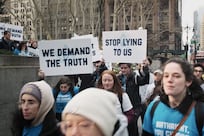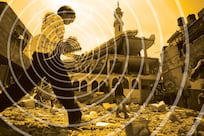Since 1916, underground fires in India's Jharia coal field have caused deaths and illnesses in the mining villages. Unhappy with government solutions, residents are turning to protests to find a way out.
"Only we know how it is to live here," says Arshad Ansari, 22, a resident of Bokapahari, a mining village in the Jharia coal field and the biggest coal mining town of eastern India. "Every day, I fear my house will fall on my head."
The bright-eyed young man lives with his wife, Khusboo Khatun, in a tiny shack, less than a kilometre from the mines. The red moraine road leading to his house is marked with deep, charred cracks from where thick, white smoke spirals out, spreading a pungent odour. Trees stand charred and grass patches have gone bald and yellow. It's an apocalyptic scene.
Hundreds of thousands of people like Ansari, living in the Jharia coal field that spans about 280 square kilometres of the Damodar river valley, are courting death every day - a death that comes from right under their feet.
First started in this area in the late 1800s, coal mining can be dangerous if not managed properly. Coal that comes in contact with oxygen can ignite and burn and, once started, an underground fire is almost impossible to put out. The first underground fire in Jharia was detected in 1916 and the coal seams have been burning ever since. According to official records, there are 70 separate underground fires burning in and around Jharia. Unofficial accounts peg the number in the hundreds.
"One day, I started to vomit because of the smoke," says Ansari, a worker in a private mine. "My head felt heavy. I thought I would faint." Ansari was born here and grew up amid the fire and smoke. "But now it has got worse," he says.
Ansari is one of hundreds of workers and residents of the region, fed up with government inaction, to join protest groups for better living conditions. In March, a group of residents blocked vehicles in the town of Dhanbad, near Jharia, to protest the slow fire-fighting efforts for the Jharia fires. Residents of other towns in the area squatted as well in show of support, according to the Times of India.
But so far, not much has changed.
A kilometre away from the pall and gloom of Bokapahari lies the town of Jharia, known for its vast reserves of prime coking coal, which is used in the steel plants. Located 34km south of Dhanbad, in the state of Jharkhand, this seems like just another small town in India: dirty and over crowded, with potholed roads, chaotic traffic jams and frequent power cuts.
But the underground coal fires have spread in all the mining areas and are steadily growing, including here. Houses have begun to fall in some places as the fire rapidly eats up layers of the prized fossil fuel, regularly bursting open the surface and collapsing land, water pipes and houses.
There are thousands of underground coal seam fires burning all over the world, including China, New Zealand, Europe and the US, among other areas. But in Jharia, the problem is the number of people living right overtop the fires.
Bharat Coking Coal Limited (BCCL) is the nationalized company that controlsthe coking coal resources in the country and operates in the region. It has been taking measures to divert roads and pipelines to safer areas to avoid the dangers of the fires, but accidents keep happening.
One such accident occurred in the Kujama mining village, which is populated by daily wage earners working in the private coal companies and by low-level employees of BCCL.
A few years ago, Jyoti Kumari, a 15-year-old girl, was going about her morning routine when she fell into a fiery pit that opened from a landslide.
After a three-hour struggle by rescue workers, her seared, lifeless body was brought from the ground.
"Her frame had shrunk," says Shravant Sinha, Kumari's grandfather.
A few days after the incident, BCCL paid the family 20,000 rupees (Dh1,319) in compensation.
Records show that at least one person has died every year in past five years because of landslides induced by mine fires. Yet, given the lack of educational and employment opportunities, the large number of unorganized labourers, earning $2 (Dh7) a day, are left with little choice but to stay and work here.
The coal mining sector is increasingly becoming mechanized and privatized. The emphasis on cost cutting has also resulted inopencast mining (digging the coal from an open pit as opposed to the normal mining practice of tunnels and shafts) and inadequate safety measures.
In the craggy landscape, streaked with dizzyingly deep, rust-coloured opencast pits, men, women and children crawl up and down the sides, past the fire, loose earth and poisonous smoke, carrying basketfuls of coal and wearing flip flops. The earth has been baking here for ages and it is impossible to walk barefoot.
Constant heat, smoke and coal dust make the air highly polluted, leaving nearly 60 per cent of the region's populace with allergies and severe respiratory illnesses such as asthma, breathlessness and rhinitis.
In the poverty-stricken Deepu Dhowra village, Manju Bhuiyan, 37, knows what it's like to make a living while suffering from asthma. Her husband is a migrant labourer currently living in another state. She wakes up around 5am every morning, makes tea for her two children and herself and draws water from a hand pump that is a 30-minute-walk away from her home, before setting off to work. Bundling her sack, she goes to the nearby mine to collect coal that has fallen off trucks. She then walks an hour with a 30-kilogram sack on her head to reach the middlemen, who will supply the coal in the illegal coal market of Jharia and give her a tiny share. With this much hard work she often gets seriously ill, but when asked if she sees a doctor, she just stares with her pale, yellowish eyes, deep set in her thin, sunburnt face.
Most people in her village suffer from the same problems: poverty and poor health. With no education and no other opportunities, they face a desperate situation, barely managing enough food to survive. Their meagre meals include rice and salt. Medical attention doesn't factor into the category of basic needs.
Over the last few years, large sums of money have been spent trying to arrest the fire and stop the large-scale human and environmental devastation. But the problem remains.
BCCL maintains that the coal has to be dug out, the logic being to get the coal before the fire gets it.
"All other scientific methods have failed," says Ashis Kumar Sarkar, director of projects and planning for BCCL. These methods involve filling the holes with sand or water to extinguish the fire and trench cutting to cut off the fire's path from more fuel, among others. According to him, the methods have worked in a "localized way" but are not enough to stop the fire everywhere. As a result, the residents of many affected areas have to move.
To carry out this huge rehabilitation and fire-fighting project, a master plan called Jharia Action Plan (JAP) was established in 2003. The coal ministry allocated about 711.2 billion rupees for the project. The money has been given to BCCL and the Jharia Rehabilitation Development Authority (JRDA) - a Jharkhand government body carrying out the rehabilitation plan.
India has a proven reserve of 93 billion tonnes of unmined coal, sitting under the forested and inhabited territory. Yet due to its demand, India remains the fourth-largest importer of coal in the world. Some experts think the Jharia fires can be doused by filling the mines with inert materials to cut the flow of oxygen, but this would render the coal inaccessible and difficult to mine afterward. The way the supply-and-demand chain stands, the Indian coal industry just cannot afford to put the Jharia fire out.
So, a relocation project is underway to move more than 50,000 people living in dangerous areas. A building complex has been built for refugees in the district of Belgharia - a poorly connected, forested territory about 10km away from Jharia. But those who have moved feel cheated because of the frequent power cuts, a scarcity of water and the remoteness from work sites.
"I have to ride my cycle for about an hour in that jungle to reach the mine," says Mohan Bhuiyan, 33. Sometimes, thefts happen on the way, he says. "No one would hear even if you shout your lungs out."
Most of the people who relocated from Jharia, he says, have yet to receive the compensation money for the move - about 60,000 rupees. "What good is such rehabilitation?" he asks.
The JRDA could not be reached for comment on the situation.
Many do not want to relocate. They feel that the fire-fighting efforts lack sincerity and that BCCL and the private companies want people to move from the lands so they can expand their opencast mining operations. At present, more than 50 per cent of BCCL's total mining operations are done through opencast mining.
However, BCCL insists that the accusations are unfounded and maintains that the problem is on too large a scale to be controlled easily.
"This is the biggest rehabilitation operation in world history, with the largest number of people to be moved," says Sarkar. "Which government initiative goes without people resenting?" he asks. "We are doing the best we can. But yes, there have been some issues regarding [the relocations]. But we are not directly involved with that," he says. It is the Jharkhand government's responsibility for the relocation process.
Caught in the vicious loop of a life-threatening fire and a fire-fighting effort that they don't trust, people are banding together in protest movements. A non-governmental organisation called Jharia Bachao Andolan Samiti (Save Jharia Movement Committee) has been fighting for safe mining, proper rehabilitation and fire fighting since 1997. Many other small groups have also been formed.
Ansari has joined one such protest group in Bokapahari. "We want the government to give us good rehabilitation, otherwise we won't go," he says. According to Ansari, the 60,000 rupees offered by the JRDA is much less than what his land is worth. "Give us the money and we will move on our own. We can build our own house if we get the money."
What if their demands go unheard? "Anything can happen, then," insists Ansari. "This is a matter of our homes. We will guard it with our lives."





